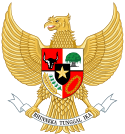Partia Wolności (Indonezja)
 | |
| Państwo | |
|---|---|
| Skrót | PM |
| Lider | Rosmawi Hasan |
| Data założenia | 10 października 2002[1] |
| Adres siedziby | |
| Ideologia polityczna | |
Partia Wolności (ind. Partai Merdeka) – indonezyjska, nacjonalistyczna partia polityczna o profilu sekularnym.
Historia i wyniki wyborcze
Partia została założona 10 października 2002 roku w Dżakarcie przez grupę aktywistów rozczarowanych aktywnością innych ugrupowań politycznych powstałych po upadku reżimu gen. Suharto.
Po raz pierwszy ugrupowanie wystartowało w wyborach parlamentarnych w 2004 roku rejestrując swoje listy w 22 prowincjach Indonezji[1]. Ostatecznie partia zdobyła 0,7% głosów, nie uzyskując w ten sposób ani jednego mandatu w Ludowej Izbie Reprezentantów oraz Regionalnej Radzie Reprezentantów[2]. W kolejnych wyborach zorganizowanych w 2009 roku, PM uzyskała wynik na poziomie 0,11% ważnie oddanych głosów co również nie przełożyło się na ani jeden mandat w jakiejkolwiek z izb[3]. Ugrupowanie nie wystartowało w wyborach parlamentarnych w 2014 roku[4].
Przypisy
- ↑ a b A. Ananta, E. Nurvidya Arifin, L. Suryadinata, Emerging Democracy in Indonesia, Singapur 2005, str. 16.
- ↑ N. Hosen, Shari'a & Constitutional Reform in Indonesia, Singapur 2007, str. 200.
- ↑ Hasil Pemilu 2009 (indonez.). DPR-RI. [dostęp 2017-12-19]. [zarchiwizowane z tego adresu (9 stycznia 2021)].
- ↑ T. Lansford, Political Handbook of the World 2016-2017, Londyn 2017, str. 685.
Media użyte na tej stronie
bendera Indonesia
Autor: Achmadmaulanaibr, Licencja: CC BY-SA 4.0
Logo of Independent Party (Indonesia)
State emblem of Indonesia is called Garuda Pancasila. The main part of the coat of arms is the golden mythical bird Garuda with a shield on its chest and a scroll gripped by its leg bears the national motto: "Bhinneka Tunggal Ika", roughly means "Unity in Diversity". The shield's five emblems represent Pancasila, the five principles of Indonesia's national philosophy. The numbers of feathers was meant to symbolize the date of Indonesian Proclamation of Independence; 17 feathers on each wings, 8 tail feathers, 19 upper tail feathers (under the shield, above the tail), and 45 neck feathers; all symbolize 17-8-1945; 17th August 1945. Garuda Pancasila was designed by Sultan Hamid II of Pontianak, and was adopted as national coat of arms on February 11, 1950.



